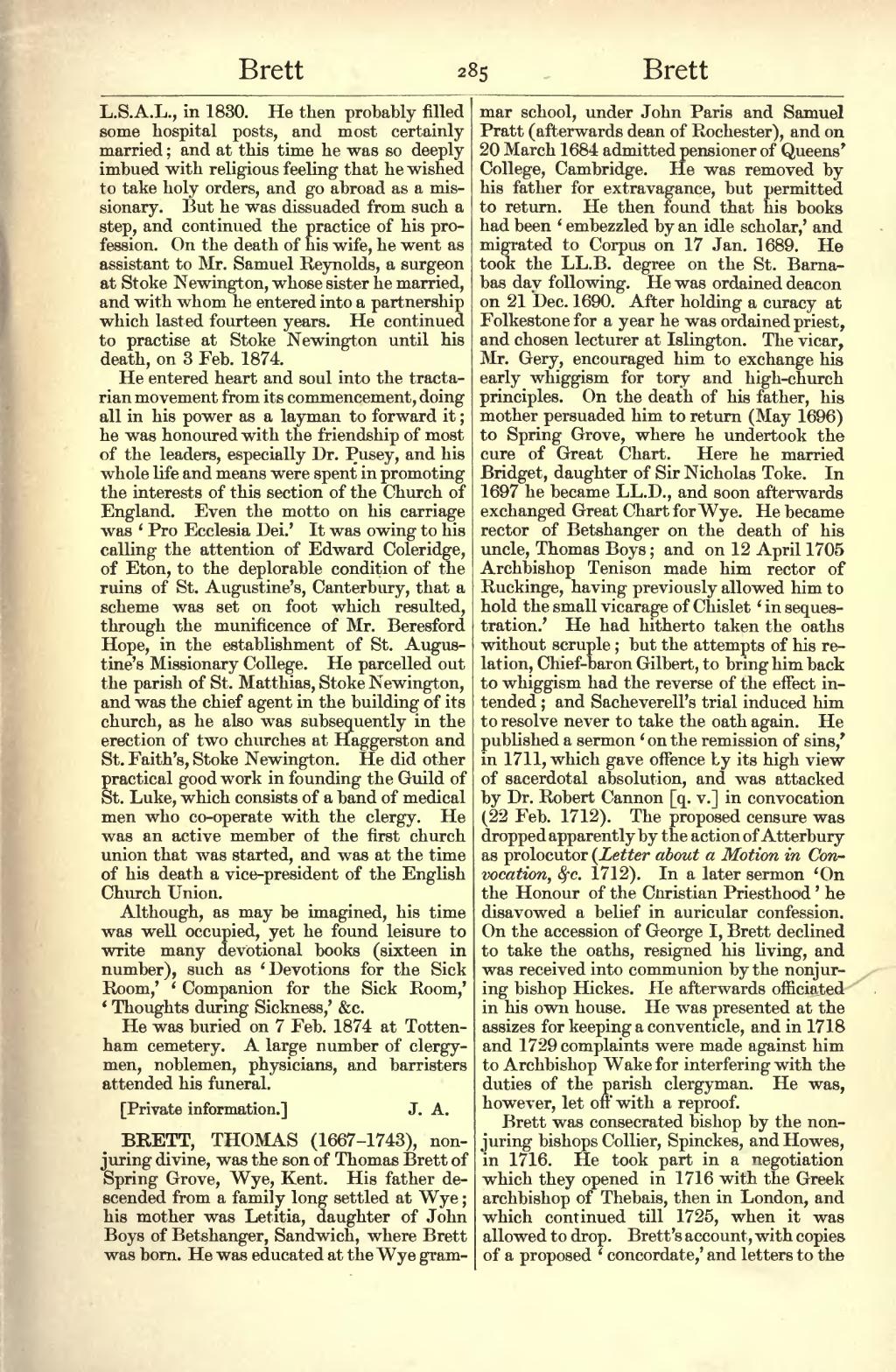L.S.A.L., in 1830. He then probably filled some hospital posts, and most certainly married; and at this time he was so deeply imbued with religious feeling that he wished to take holy orders, and go abroad as a missionary. But he was dissuaded from such a step, and continued the practice of his profession. On the death of his wife, he went as assistant to Mr. Samuel Reynolds, a surgeon at Stoke Newington, whose sister he married, and with whom he entered into a partnership which lasted fourteen years. He continued to practise at Stoke Newington until his death, on 3 Feb. 1874.
He entered heart and soul into the tractarian movement from its commencement, doing all in his power as a layman to forward it; he was honoured with the friendship of most of the leaders, especially Dr. Pusey, and his whole life and means were spent in promoting the interests of this section of the Church of England. Even the motto on his carriage was 'Pro Ecclesia Dei.' It was owing to his calling the attention of Edward Coleridge, of Eton, to the deplorable condition of the ruins of St. Augustine's, Canterbury, that a scheme was set on foot which resulted, through the munificence of Mr. Beresford Hope, in the establishment of St. Augustine's Missionary College. He parcelled out the parish of St. Matthias, Stoke Newington, and was the chief agent in the building of its church, as he also was subsequently in the erection of two churches at Haggerston and St. Faith's, Stoke Newington. He did other practical good work in founding the Guild of St. Luke, which consists of a band of medical men who co-operate with the clergy. He was an active member of the first church union that was started, and was at the time of his death a vice-president of the English Church Union.
Although, as may be imagined, his time was well occupied, yet he found leisure to write many devotional books (sixteen in number), such as 'Devotions for the Sick Room,' 'Companion for the Sick Room,' 'Thoughts during Sickness,' &c. He was buried on 7 Feb. 1874 at Tottenham cemetery. A large number of clergymen, noblemen, physicians, and barristers attended his funeral.
[Private information.]
BRETT, THOMAS (1667–1743), nonjuring divine, was the son of Thomas Brett of Spring Grove, Wye, Kent. His father descended from a family long settled at Wye; his mother was Letitia, daughter of John Boys of Betshanger, Sandwich, where Brett was born. He was educated at the Wye grammar school, under John Paris and Samuel Pratt (afterwards dean of Rochester), and on 20 March 1684 admitted pensioner of Queens' College, Cambridge. He was removed by his father for extravagance, but permitted to return. He then found that his books had been 'embezzled by an idle scholar,' and migrated to Corpus on 17 Jan. 1689. He took the LL.B. degree on the St. Barnabas day following. He was ordained deacon on 21 Dec. 1690. After holding a curacy at Folkestone for a year he was ordained priest, and chosen lecturer at Islington. The vicar, Mr. Gery, encouraged him to exchange his early whiggism for tory and high-church principles. On the death of his father, his mother persuaded him to return (May 1696) to Spring Grove, where he undertook the cure of Great Chart. Here he married Bridget, daughter of Sir Nicholas Toke. In 1697 he became LL.D., and soon afterwards exchanged Great Chart for Wye. He became rector of Betshanger on the death of his uncle, Thomas Boys; and on 12 April 1705 Archbishop Tenison made him rector of Ruckinge, having previously allowed him to hold the small vicarage of Chislet 'in sequestration.' He had hitherto taken the oaths without scruple; but the attempts of his relation, Chief-baron Gilbert, to bring him back to whiggism had the reverse of the effect intended; and Sacheverell's trial induced him to resolve never to take the oath again. He published a sermon 'on the remission of sins,' in 1711, which gave offence by its high view of sacerdotal absolution, and was attacked by Dr. Robert Cannon [q. v.] in convocation (22 Feb. 1712). The proposed censure was dropped apparently by the action of Atterbury as prolocutor (Letter about a Motion in Convocation, &c. 1712). In a later sermon 'On the Honour of the Cnristian Priesthood' he disavowed a belief in auricular confession. On the accession of George I, Brett declined to take the oaths, resigned his living, and was received into communion by the nonjuring bishop Hickes. He afterwards officiated in his own house. He was presented at the assizes for keeping a conventicle, and in 1718 and 1729 complaints were made against him to Archbishop Wake for interfering with the duties of the parish clergyman. He was, however, let off with a reproof.
Brett was consecrated bishop by the nonjuring bishops Collier, Spinckes, and Howes, in 1716. He took part in a negotiation which they opened in 1716 with the Greek archbishop of Thebais, then in London, and which continued till 1725, when it was allowed to drop. Brett's account, with copies of a proposed 'concordate,' and letters to the
